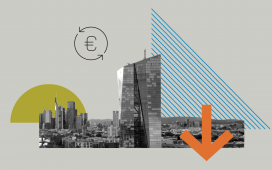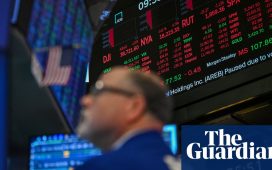This article is an on-site version of our Unhedged newsletter. Sign up here to get the newsletter sent straight to your inbox every weekday
Good morning. I’m no Luddite, but virtual reality headsets strike me as something out of a dystopian future, as imagined by the film director David Cronenberg. All the more so when they cost $3,500. That said, I’ve underestimated Apple plenty of times before. Email me with your grand vision of computing’s future: robert.armstrong@ft.com.
Something big has happened. Specifically: nothing
The most significant thing that has happened on Wall Street in the past few months is a reassessment of inflation, and therefore the likely path of Federal Reserve policy.
The market-implied federal funds rate for the end of this year has risen steadily since March. Three months ago, the broad consensus was that we had seen the peak, and rates would soon start to fall. Now the consensus is that rates will still be where they are — about 5 per cent — in six months’ time. Here is the evolution of the futures market-implied fed funds rate for December 2023:

But it is wrong to characterise this as something happening. What it really is is something not happening, something that everyone thought was going to happen. The big fall in expectations for the year-end policy rate in early March happened because a banking crisis seemed imminent. What has happened since, as reflected in the rising line on the chart, is that crisis not coming to pass — and, while we are at it, a debt-ceiling crisis not happening, either.
As a result of these two non-events, policy expectations have simply returned to somewhere around the level they were before Silicon Valley Bank mismanaged itself into insolvency. And of course there is a third thing that has not happened, possibly the most important non-event of them all. The Federal Reserve’s very rapid 5 percentage point increase in the policy rate has not broken the US economy.
This last point is worth lingering on. The Fed’s quick tightening job does seem to have forced core inflation down a bit (core CPI has gone from an 8-ish per cent annualised rate to 5-ish per cent) and kept inflation expectations well anchored. Meanwhile, unemployment remains near pre-pandemic and indeed near multi-decade lows.
As Unhedged has noted, there are significant weaknesses at the periphery of the economy. But to my surprise (and I would think to the surprise of most people) while we are experiencing an economic slowdown, there are no signs of crisis or recession in the aggregate economy. Earnings are a great example. In the first quarter, according to FactSet’s earnings monitor, earnings at S&P 500 companies fell 2.1 per cent from the year before. That’s not great, but just two months ago, analyst consensus was for a 7 per cent decline. Earnings, following the broad economy, have surprised to the upside. Correspondingly, earnings estimates for this year and next are starting to creep upwards after a long period of decline.
Where does this year of non-events leave us? The Wall Street consensus, as far as I can make out, is that what we are experiencing is recession (or near-recession) delayed. A day of reckoning is coming. That day could take a number of forms:
-
The slowdown visible in certain parts of the economy and certain economic indicators will show up in falling corporate earnings. This widely held view is usually expressed in a dual-axis chart plotting a chosen indicator (manufacturing ISM surveys; the yield curve; and index of leading indicators; or whatever) against earnings growth, showing that earnings usually follow the chosen indicator, but that the two have diverged. The implication is that the normal relationship will be re-established through a fall in earnings. Here is my favourite example of this species, as presented by Strategas’ Ryan Grabinski, comparing S&P earnings to South Korean exports, which are a global activity bellwether:
-
It could be that the economy has been supported by the pandemic-era build-up of household savings, and the wheels will finally come off when those savings are depleted. A recent paper from the San Fransisco Fed estimated that at the current burn rate, the excess will be exhausted sometime around the fourth quarter.
-
The trouble could kick off when companies have to refinance their debt at higher rates. There is a so-called “maturity wall” of high-yielding debt coming due next year. According to Morgan Stanley, $260bn in US high-yield bonds will be within their 18-month “refinancing window” by January. That is more than double the current total. Debt costs go up, margins go down, hiring stops, unemployment rises. Recession.
So much for the nasty, left tail of the distribution of outcomes from here on out. What about the happy right tail? It’s easier to explain: inflation continues to fall as the year goes on, the economic slowdown remains gentle, and the Fed cuts rates slowly and deliberately starting next winter. In other words: nothing keeps on happening.
A brief and possibly obvious comment about the sexy six tech stocks
The other very big thing to happen in markets this year is the massive outperformance of six big tech companies, which has accounted for essentially all of the positive returns in the S&P 500. The sexy six (yes, I am trying to make that name happen) of Alphabet, Apple, Amazon, Meta, Microsoft and Nvidia have been treated (in Unhedged, among other places) as a unitary phenomenon, driven largely by AI hype. But there is an important distinction to be made among them. A table (data from S&P Capital IQ):
Earnings estimates are flat or down this year at all of the companies except Meta and Nvidia, where they are up quite a lot. Valuations are up a lot at all the companies, except Nvidia, where the P/E multiple has risen a moderate 15 per cent.
This simple exercise makes it clear that the sexy six are heterogeneous, and that their future returns are likely to be, as well. Alphabet, Amazon, Apple and Microsoft are experiencing a valuation surge. Nvidia is undergoing a rapid reappraisal of its short-term earnings prospects. Meta is a little of both.
One good read
I have written approvingly about the royal family’s clothes. Clothes aside, though, I have a lot of sympathy for this guy.












